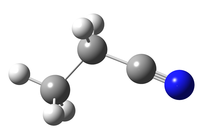|
The observed transitions were taken from
(1) K. Demyk, H. Mäder, B. Tercero, J. Cernicharo,
J. Demaison, L. Margulès, M. Wegner, S. Keipert, and M. Sheng,
2007, Astron. Astrophys. 466, 255.
With respect to the entry from Apr. 2007, additional
extensive data were used from
(2) C. Richard, L. Margulès, R. A. Motiyenko, and J.-C. Guillemin,
2013, Astron. Astrophys. 543, Art. No. 135.
The transitions from (1) and (2) were used as reported
in (2). Higher order parameters, including two from (2),
were kept fixed to those of the main isotopolog,
see e055502.cat.
Please note: In the case of
asymmetry doublets with splitting less than 0.1 kHz,
(1) and (2) have listed only one transition. There is no effect
on the spectroscopic parameters or on the predictions, except
that in the merged catalog file only one transition will be
flagged. Corrections had been made in the line list for (1),
but not for (2) because of the extensive data.
Predictions with uncertainties exceeding 0.5 MHz
should be viewed with caution. The predictions are deemed
to be reliable throughout for astronomical observations.
The 14N hyperfine splitting is negligible in most instances.
However, it may be resolved for low values of J. Therefore, a
separate hyperfine calculation together with
partition function values are provided for J' ≤ 10
and frequencies below 92 GHz. At present, the hfs parameters
were taken from the main isotopic species. Deviations will
be small, but maybe not always negligible.
The partition function values below refer to the ground
vibrational state only.
Vibrational correction factors have been derived for
the main isotopolog in the harmonic approximation.
Errors caused by isotopic substitution are small.
The dipole moment was assumed to agree with that of the main
isotopic species:
(3) A. Krasnicki, Z. Kisiel,
2011, J. Mol. Spectrosc. 270, 83.
Some small deviations are expected to occur, but these are
probably within the experimental uncertainties.
|
